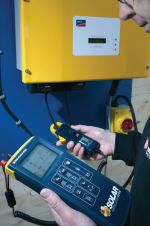 Phil Old, applications engineer at Seaward Solar, explains that to guarantee solar PV system safety and performance it is crucial to be aware of electrical installation standards
Phil Old, applications engineer at Seaward Solar, explains that to guarantee solar PV system safety and performance it is crucial to be aware of electrical installation standards
The introduction of new solar PV test equipment into the market has helped to make grid connected solar PV system installation a mainstream electrical contracting activity.
For a qualified electrician the installation process is unlikely to cause too many headaches, however, PV systems are unusual in that the energy source cannot be switched off. If there is daylight falling on a PV panel it will produce electricity and it is possible for a relatively small array of only a few panels to deliver a potentially lethal shock.
Another important point to remember is that PV panels generate DC voltage, which is not always commonly used by electricians in their work. In addition‚ because of the current limiting properties of PV cells‚ they are incapable of producing sufficient fault currents to operate over current protection devices such as fuses. Once established a fault may remain undetected, not only posing a fire and safety hazard for an extended period but also wasting energy generated by the PV system.
Without fuse protection against such faults, elimination of a fire risk can only be achieved by both good system design and careful installation with appropriate inspection and testing.
 Installation overview
Installation overview
The essential need for all installers of PV systems is to satisfy Microgeneration Certification Scheme (MCS) requirements (for systems up to 50kW), as detailed in the DTI’s Guide to Photovoltaics in Buildings (soon to become an MCS publication). This is fundamentally aligned to the BS EN 62446:2009 standard for grid connected PV systems.
When they are exposed to sunlight PV arrays generate DC voltage which is converted to AC by an inverter which in turn feeds into the AC mains supply of a building.
The requirements for PV installations are designed to ensure the electrical safety of the system and installation personnel as well as the verification of performance and power output of the system.
In general terms the installation of domestic grid connected PV systems falls within the scope of Part P of the Building Regulations and it is the responsibility of the installer to ensure that systems are installed according to the existing BS 7671 electrical installation standard – the 17th Edition IEE Wiring Regulations.
However, there are some further requirements that need to be considered when dealing with the inspection and testing of DC circuits associated with PV arrays, for example the IEE Guidance Note 7 Special Locations on solar photovoltaic power systems.
Also required is completion of Engineering Recommendation G83/1 or G59/2 which are the installation commissioning confirmation forms for the connection of Small Scale Embedded Generators‚ such as PV arrays‚ of up to 16A per phase with public low voltage distribution networks.
BS EN 62446
The MCS has adopted the principles of BS EN 62446 as the basis for its testing and documentation regime.
Building or electrical works in the vicinity of a PV array are also likely and the ownership of a system may change. As a result‚ the standard recognises that only by the provision of adequate documentation at the outset can the long term performance and safety of the PV system be ensured.
The standard therefore sets out the information and documentation that should be provided to the customer following the installation of a solar panel system and also the initial (and periodic) electrical inspection and testing required.
In short the standard sets out measures to ensure that the PV panels and electrical supply connections have been wired up correctly, that the electrical insulation is good, the protective earth connection is as it should be, and that there has been no damage to cables during installation.
BS EN 62446 also requires inverter details to be recorded and MCS requires that records are kept.
Instrumentation
There are a range of instruments available that are labelled as ‘solar testers’ so it’s important to make the correct choice to ensure that the various compliance requirements are met.
The absolute minimum testing that needs to be undertaken involves continuity measurements (where applicable), open circuit voltage, short circuit current, insulation and irradiance.
Some contractors have used multiple instruments that typically include an earth continuity and insulation resistance tester‚ a multimeter, DC clamp meter along with various associated connectors and leads. However, this can be cumbersome, time consuming and dangerous, as not all of the tests required by BS EN 62446 will be covered by these ‘homemade kits’.
The alternative for the installer is to use an all in one combination PV tester and dedicated electrical test kits that enable measurements to be taken in a fast, safe and efficient fashion.
As well as providing a more efficient means of working, these kits can record and provide results in a format that is compatible with data recording programs that assist in the creation of system information folders for use in customer test certificates and system commissioning packs.
Seaward Electronic
T: 0191 586 3511


